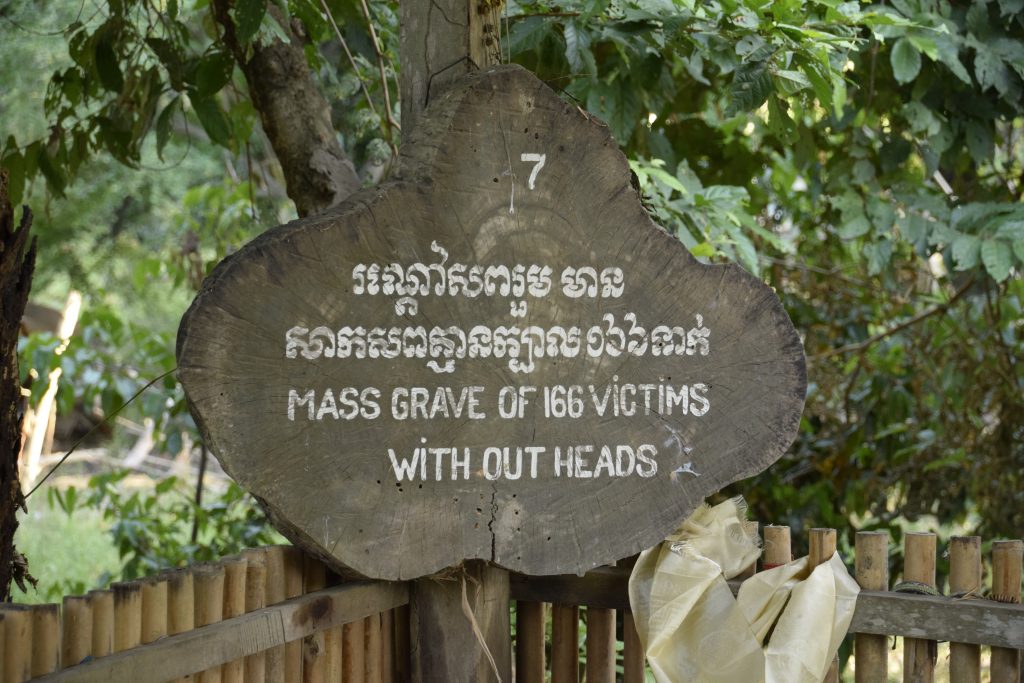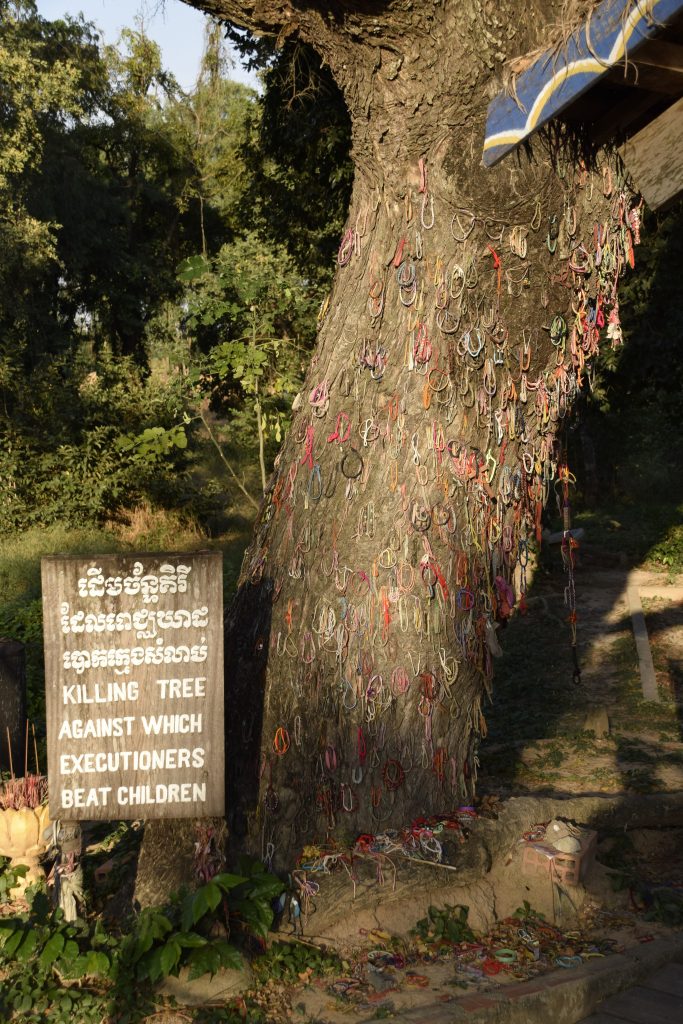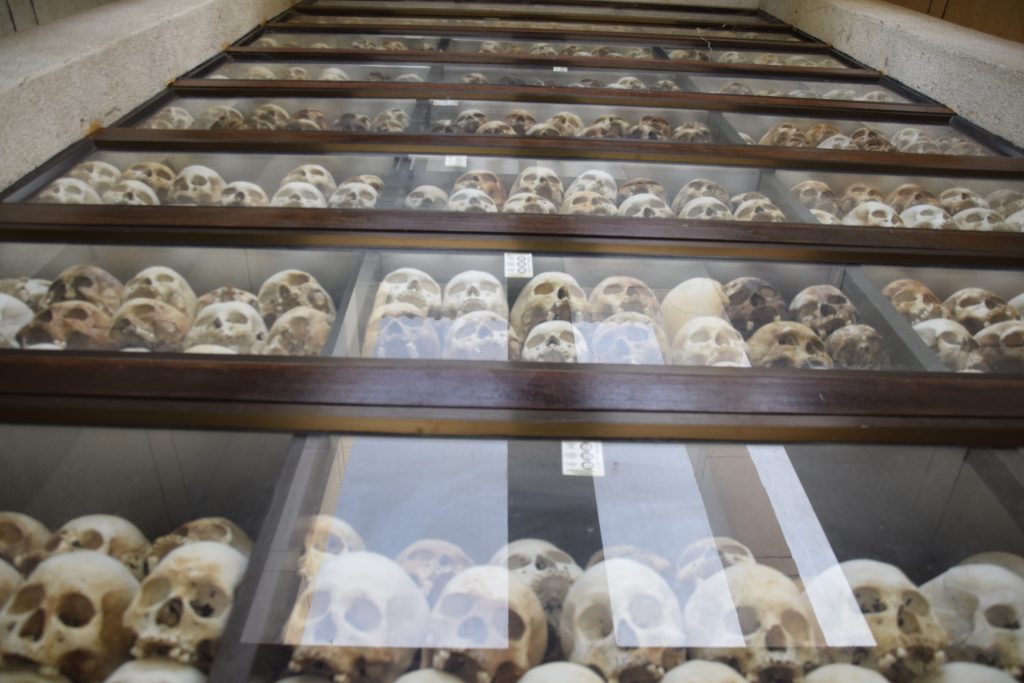The blood stains on the tile floor had been there for more than 40 years, but standing in the room of the former high school classroom-turned-prison, I could almost hear the screams of the prisoners who were tortured there. We were at S-21, the place where more than 14,000 prisoners were processed and tortured before being sent to be killed a short distance away. Seven people survived, including two children.

A History Lesson
Although I knew the basic facts of the genocide under Pol Pot’s regime in Cambodia, I learned so much more from touring the prison and killing fields. Pol Pot spent a lifetime planning for his vision of Cambodia, but few people really understood what he was up to until it was too late. When he finally reached power in 1975, people were actually celebrating in the streets of Phnom Penh because he had driven the Vietnamese out of the country. Pol Pot and his party, the Khmer Rouge, were now in charge.
By the afternoon, Phnom Penh, the capital city, was a ghost town. Pol Pot and his soldiers forced everyone to leave the city on foot so that they could work in the countryside as farmers to support the Khmer Rouge. Those who didn’t leave were killed on the spot. These city dwellers knew little of farming and many eventually starved to death. If they did grow food, most of it was taken by the government. Religion and money were also banned.

In addition to emptying out the cities, all of the schools in the country were closed. Pol Pot considered anyone with an education an enemy. Although he was a former high school teacher, Pol Pot had all known teachers executed. Doctors, lawyers, anyone with a profession, were rounded up and sent to be processed before going to one the country’s’ many killing fields for execution. Families, including children, were also killed. If a lawyer was captured, his entire family was taken as well.
About 90% of artists, intellectuals and teachers were killed. One in four Cambodians died during this time.

Torture and Killing
From 1975-1979, Tuol Sleng, also known as S-21, was a high school where prisoners were interrogated before being sent to be killed. Torture was used to force false confessions from the prisoners. Many reluctantly gave up names of fellow Cambodians in order to stop the torture, but this just led to more arrests. The soldiers themselves would be killed if they did not get a confession from a prisoner. All prisoners were photographed and meticulous records were kept. The regime accounted for every killing and if the numbers didn’t match up, someone would pay the ultimate price.
S-21 was just one of many such prisons, and the killing fields we visited were also replicated across the country. Many have not even been excavated because they are in such remote locations.

Lessons for Today
It is impossible to learn anything about Cambodia without learning about Pol Pot’s regime. It is hard to understand how it happened, and hard to imagine that this was happening while I was a middle school student in Connecticut, but the message we heard over and over again is that it has happened since and will happen again.
We were fortunate to meet one of the seven people who survived S-21. His tale is chilling and so painful to hear, but every day, he visits his former prison to share his story with visitors. He wants the world to learn from this and understand that it is our responsibility to prevent it from happening again.

More information about the Khmer Rouge, Pol Pot and the genocide can be found at this site: https://tuolsleng.gov.kh/en/


























February 13, 2017 @ 06:04
Wow, Tim…..what a moving experience………….
February 13, 2017 @ 22:51
It really was.
February 13, 2017 @ 06:06
Just horrific! What an amazing opportunity for you to get the chance to visit the Killing Fields…a place you only knew of through the news as a young man.
February 13, 2017 @ 22:51
I remember seeing the photos decades ago – they never left my mind.
February 13, 2017 @ 06:35
What a horrific and sad place. I remember hearing accounts in the news but the details and pictures are truly chilling.
February 13, 2017 @ 22:52
It was chilling, but today it is a place of peace and hope.
February 13, 2017 @ 07:32
How absolutely horrible! IT must have been hard to see even today.
February 13, 2017 @ 22:54
Very hard. Nothing is hidden from the visitors, but the goal is to educate which is why I decided to write about it.
February 13, 2017 @ 07:36
Very sad to see.
February 13, 2017 @ 07:42
An opportunity to pray here for all people and nations that this will not be repeated
February 13, 2017 @ 22:56
Amen.
February 13, 2017 @ 08:30
I usually have my breath taken away by the beauty of your pictures and words along side. Today I had a pit in my stomach and had a hard time looking at all your pictures and taking in your words.
February 13, 2017 @ 22:56
Thanks for reading, even when it’s hard to take in.
February 13, 2017 @ 22:06
It was one of the most sobering experiences – to walk around those fields,to look at the “killing trees” and feel the tremendous loss of human life and potential. It makes it even worse when you look at all the beautiful children and realize what could have been. I am from Argentina and as you say, it could happen again and it did in a smaller degree in my country – shame on humankind that we allow such history to be repeated. Thanks for the photographs and the moving writing – I did not have the heart to take pictures – you did a great job capturing it all.
February 13, 2017 @ 23:01
So glad to hear your perspective, Monica. I didn’t want to take pictures either, but in the end decided it was worth sharing. Cambodians want the world to understand what happened and that it will continue unless we speak up.
March 28, 2017 @ 12:33
Hi Tim,
As you see I am doing catch up reading, what a difficult story to read, a picture is worth a thousand words. Thanks for sharing, although it sends chills up my spine. What a journey!
March 29, 2017 @ 23:06
Thanks for taking the time to read it.